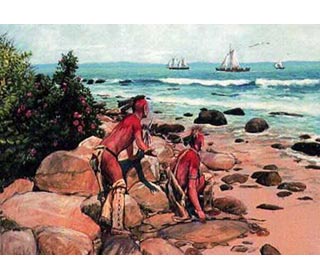Interesting history and fast facts about the Pequot War: Name of Conflict: Pequot War
Location: Southeastern Connecticut
Date Conflict started: 1634
Date Conflict ended: 1638
Result: Pequot were defeated
Combatants: Pequot tribe
Pequot Leaders: Sassacus, a Pequot sachem
Opponents: English colonists and their Native Indian allies
Leaders: Captains John Underhill, John Endecott, Myles Standish, John Mason and Robert Seeley Pequot War Summary and Definition
Pequot War Summary and Definition: The Pequot War was a short, vicious war in 1634-1638 between the Pequot tribe, who were members of a powerful tribe of Algonquian-speaking Indians of Connecticut, against an alliance of the Massachusetts Bay, Connecticut and Plymouth English colonies with their Indian allies, the Narragansett and Mohegan tribes. The Pequot were defeated in a crushing defeat in which they were forced to sign the Treaty of Hartford declaring the Pequot nation to be dissolved. The History and Cause of the Pequot War
The history, reason and cause of the Pequot War were as follows: The lucrative fur trade attracted colonists to the area The colonists encroached on the Pequot homelands Inter-tribal warfare broke down alliances and weakened the Native Indians The Dutch and the English colonists and traders made alliances with different tribes to strengthen their forces and power in Connecticut In 1633 the Massachusetts Bay Colony began to manufacture wampum, the shell beads that Eastern Woodlands tribes used for currency. Wampum had previously been controlled by the Pequot Unscrupulous Europeans demanded tributes from the Pequot to avoid bloodshed - a practise that could not be condoned by the once all-powerful Native Americans. Hostilities between the Europeans and the Pequot escalated resulting in the Pequot War
The Significance of the Pequot War
The significance of the Pequot War in history was that it tipped the balance of military power to the English, instead of the Dutch, opening the way to New Englandís settlement. The penalties of fighting in the Pequot War brought the wrath of the English and their allies on to the Pequot people. The Treaty of Hartford stated that survivors of the Great Swamp fight were to be divided as slaves among the Indian allies of the English. The Hartford Treaty also stated that no Pequot could inhabit former Pequot territory. And finally the name Pequot was to be erased and any Pequot slaves had to take name of tribes to which they are enslaved. So cruel and devastating was the outcome of this war that no Connecticut Native Americans challenged the colonies again for nearly forty years, when, in 1675, King Philip's War erupted. History Timeline of the Pequot War
This short History Timeline of the Pequot War provides facts and information about the history, years, key dates, key events and key people who fought in this war. - 1633: The Dutch establish trading posts in Connecticut. Their land claims lead to conflicts with the Pequot
- 1633: The English make land claims and grow in power
- 1633: The Massachusetts Bay Colony began to manufacture wampum
- 1634: Inter-tribal warfare between the Pequot and their enemies the Narragansett
- 1634: Smallpox epidemic transmitted initially by the European new comers.
- 1634: Death of Captain John Stone who was killed by the Western Niantic, allies of the Pequot, in retaliation for atrocities committed by the Dutch and Stone
- 1634: Pequot negotiate a Peace Treaty in Boston
- 1636: Captain John Oldham killed off Block Island
- 1636: John Endicott leads a punitive force against the Pequot, attempts to get tribute payments from the Pequot and when these were not given he burns their village
- 1636/7: Pequot Siege of Fort Saybrook and Connecticut River
- 1637: Inter-tribal warfare re-emerges between the Pequot and their enemies the Narragansett
- 1637: Captain John Mason sent to punish the Pequot at their main village. He was joined by John Underhill. They failed to take the heavily defended village so sailed east and stopped at the village of Misistuck, present-day Mystic.
- 1637: The Mystic Massacre of women, children and older men who were killed or burnt to death in their village. Only 7 Pequot survived out of an estimated 700 people.
- 1637: The remainder of the Pequot seek refuge with other southern Algonquian people
- 1637: June - Great Swamp Fight - Refugees cornered by the English. Survivors led by Sassacus seek help from the Mohawks in New York
- 1637: July - The Mohawks kill Sassacus and his warriors and send the scalp of Sassacus to the English as a symbolic offering of Mohawk friendship
- 1638: September - Treaty of Hartford - the Mohegan and Narragansett given Pequot land. The surviving Pequot were unable to find refuge with any other tribe and were sold into slavery
|
